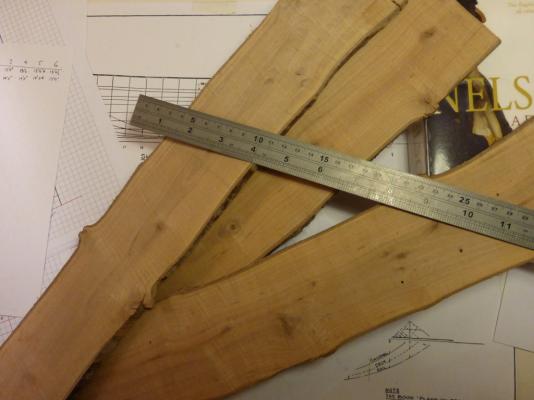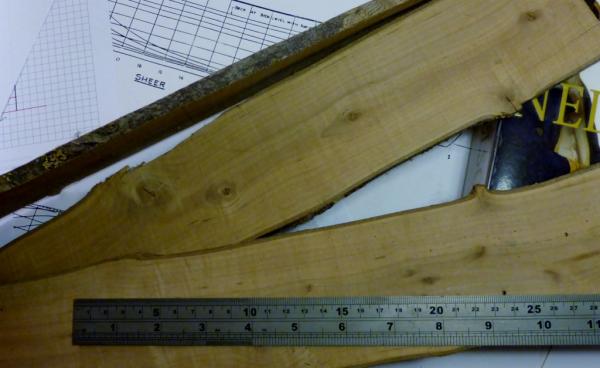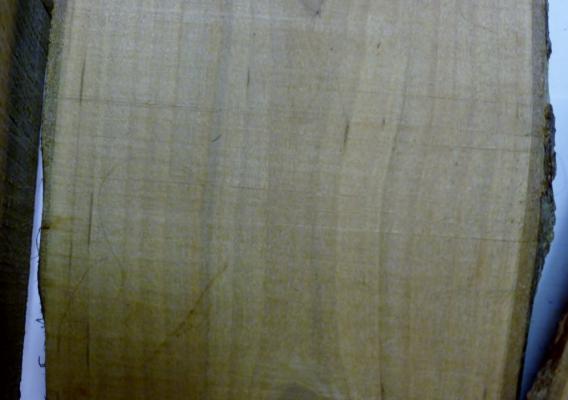-
Posts
63 -
Joined
-
Last visited
Content Type
Profiles
Forums
Gallery
Events
Posts posted by nancysqueaks
-
-
-
Dan, I don't usually tell other members of my interests but this is especially of note. As a young lad of 13 when the ship sank
I built my first ship model of her. I was really into drawing ships especially the Queens, but The Andrea Doria was very much in the
news and I thought that she was the most beautiful liner built. I shall follow your build with considerable interest. Best wishes, Nick
-
Jaager, thanks for that information. Wonderful work Crabshell did, I'm back to my stock of Apple and Cherry!.
Cheers, Nick
-
Sorry Brian if your original question has been hi-jacked a bit.
Jaager, I am sure you are right regarding Pyracantha, as the problem is naming trees and
plants over continents. The pyracantha in the UK is really a climber with shiny leaves and
red berries in the Autumn.
I also suspect we may be confusing hawthorn as well. I had decided to be a City of London
banker in my next life, I may change that to a botanist, on the other hand......
Someone must have the original Model Shipwright, not that that really sorts the problem.
Cheers, Nick
-
Jaager, I'd like to pop in here. I remember an article in Model Shipwright, probably vol 2 or so. I think it
was about 1977.
It was about Crabtree and that he had to source and season his own woods. The wood mentioned (again all from memory) was Fire Thorn,
this in the UK is called Pyracantha. One of our members is an expert on plants etc. and I'm sure he can perhaps tell us any differences
in the names in the US and the UK. Pyracantha is often used as a hedge and has a wonderful red colour In the Autumn.
The hawthorn we are discussing is a hedgerow small tree with the most distinctive beautiful flowers in May.
I'm sure someone will have the original article, would be useful to see whether my memory is working still,, both age and time of night!
Nice to clear it up though, regards, Nick
-
Hi Brian, interesting question. I live in Devon and there is an abundance of hawthorn in the
hedgerows etc. The local craft/woodworker uses hawthorn for making models of birds and
carved objects. I have not really had a good look at the objects he makes but they have a
beautiful finish. So it may be well worth grabbing some of the wood.
I'll try to contact the chap and ask him a bit about whether he processes the wood himself
and what finishes etc. This may be an opportunity I'm missing!
Best wishes, Nick
-
Hi Joshua, thanks for the book link. Very useful, and haven't seen it before. Nick
-
Hi, thank you for the replies. Joel, many thanks for the details of your rope walk.
I've not really had time to look in detail, other than the method of making the
whirls is very neat - I may put together something similar.
I'm not too clear about the looper. I can understand the rubber band to act as
resistance, but you mention this item sliding as the rope is formed. I presume
you disconnect the looper mount, but then the looper looses the tension caused
by the rubber band. What am I missing here?
Whoops hadn't read it properly! Given me a lot of food for though, and I am aiming
to copy very nearly your ideas, particularly the support of the top.
As a sort of post, similar to the one on 'where do you do yours', a few photos of members rope walks
would be of considerable interest - maybe?
Cheers, Nick.
-
Hi everyone, I'm prior to (at last) getting my Underhill Leon underway, building
a rope walk. I've been collecting the bits - track, gears, and old linen thread for
some time. And was going to copy the ideas incorporated in Nepean Longridge's
rope walk in The Anatomy of Nelson's Ships.
I then read Phil Krol's article on building his rope walk which is very similar to Longridge's
other than the top or topper is tracked and the looper is slowed by a trailing weight, whereas
in the Longridge version the top is supported by an overhead wire, and the looper is tracked.
Both produce excellent rope, is there any particular merit in either method. I favour Longridge,
or am I missing something? Your observations and any other advice on building a rope walk
would be greatly appreciated.
Regards, Nick
-
Hi Nigel, I collect as much apple as possible. A lot in the area I live in from
the old cider orchards - but one has to still be lucky.
It is harder than pear and takes a very sharp edge. Selection is the key here
even from the same log. Bends well if steamed. The finish is super to say the
least. Sometimes a bit of a wavy grain in small branches, more often a close
straight grain. Cutting tools need to be very sharp. My main use at the moment
is small deck structures and some framing.
So I'd put the word out! Regards, Nick.
-
Hi Michael, this is cooking oil and very greasy, long time to even harden!!
My only suggestion, and I'm not being funny is to wash the boat with a solution
of washing up detergent and water. Then after drying make good and apply
the decorations.
I think you may be able to run your car on cotton seed oil - best not to try though.
Regards, Nick
-
Hi again,
I agree with Jan but maybe the meths is more useful to remove any remaining oils
after hardening or oxidising?
Maybe the best policy - if we are talking about glue affixing decorations to the wood,
is to wait until the linseed oil has hardened then clean and sandpaper.
Only my thoughts remembering using linseed oil on furniture many years ago.
Regards, Nick.
-
-
Hi All, I would like to slip into this thread if I may.
Certainly save small branches of fruit wood. Not all will be super stuff but can often
be pulled into service to make small parts such as tops, belay pins, etc. etc. The thing
is that some of this small wood can be very rewarding and be of excellent quality.
I am sure that I am not along in looking at something I've made from a bit save wood
and really appreciating the finish, quality etc.
I don't do anything special, just collect the branches and leave them untouched for
about 18 months or so. Still better forget them and convert them at ones leisure.
The following are pictures of Apple wood, converted only by thru and thru sawing,
not quarter sawn after about 2 years 'seasoning'. They are approx. 3" diameter which
I think is what we are talking about. Certainly only small 'bits' are available but enough
in between the knots to build some nice ship's boats etc.
I do season larger sections of wood but sometimes small branches of say holly come my way
and these can be very useful. I am currently growing a box hedge .......
Cheers, Nick.
I've made a bit of a mess of this post but the photos are below.
.
-
Hi, yes I agree ebony is a most disagreeable wood, but can look simply stunning for wales. Ebonising
as practiced for furniture is not too tricky, and the results are really very similar to genuine ebony.
Whilst most woods can be used, filling the grain can result in poor finish, so the type of wood
used in model shipbuilding - close grained wood - apple, pear, holly, box, cherry etc. is ideal.
We are attempting to produce the deep black but satin finish. First the wood is stained as near black as possible.
The steel wool in vinegar may be a little too light, however drawing ink is excellent and I have recently used
inkjet pigment ink with very good results. Stains are also available usually for creating 'black ash'.
The stained wood now needs a finish and this is usually Shellac (French Polish) with the addition of a black pigment.
I use Vegetable Black, but the tradition is Lamp Black. The application of polish on such small pieces
of wood is easy using a small folded pad of cotton. Apply thin coats and amalgamate each coat with a polishing action,
eventually a deep shine will result. This is not what is wanted, so very fine parallel scratches are put on the surface with
either a fine cutting powder or fine grade silicon carbide paper. It is important that the scratches are in lines close together
and in the same direction.
This cutting or scratching is really best done after the polish has hardened - maybe up to a week. The finish achieved can
be 'show stopping' and is very close to looking like burnished ebony.
I am rebuilding my workshop at the moment, but will attempt to take some photos of the process for those that are interested.
A final warning - the fingers will be very black for about a week.
Apologies for long post, cheers, Nick.
-
Hi Larry, this is an interesting question. I think a lot of the time finish is a personal choice. But having said that
I suggest that that a lot of what we now think about finish has probably been influenced by what models
we have seen and what various authors may have written. I often feel Underhill's comments are rather based
on the time he wrote and the experience he had had at that time.
Certainly reading Nepean Longridge: Anatomy of Nelsons ships, shows what he felt about varnish and was an
adherent of beeswax. To obtain a (what I consider) good finish on spars I do use a form of French polishing called
(in the UK) dry shining. This is rather a basic 'wizz' over the wood, feeding it with shellac until there is a dull shine.
In the past it was used for the inner linings of draws and helped prevent dust. On the other hand looking at some
of the models in our museums they are often spoilt by over application of varnish. In Longridge's book he describes
finishing the spares (which were black) with dye and then polish.
I hope I have read your query correctly, but to sum up I feel finish is very personal and maybe Underhill may well have used
other finishes if he had the opportunity to see some of the builds in MSW.
Rather a personal view, cheers, Nick.
-
-
Hi,
I am using Draftsight to loft frames and have accidentally closed the command window. I can bring
it back to input one command using the F2 toggle, but am keen to restore it full time on top of the
drafting window. Any ideas?
Thanks in anticipation, regards, Nick.
-
Hi everyone,
I chanced to find remaindered copies of the book 'Sovereign of the Seas' by James Sephton for only £6.99 in
'The Works' (UK chain discount bookshop)
I bought a copy in Plymouth today and the shop assistant 'thinks' copies would also be in other branches.
I flag this up as this is a superb, very well researched book and would prove invaluable for modellers thinking about or
building this vessel, or indeed as a very good reference book.
Amazon have this book listed at over £16.00, and one of the reviews is well worth reading.
Hope this will prove useful information, regards, Nick
- NMBROOK and mikeaidanh
-
 2
2






How Can I Identify Lead Fittings?
in Metal Work, Soldering and Metal Fittings
Posted
Hi Bill, years ago in my first job. The chemical lab was asked to identify a lump of
metal. It turned out it had a high proportion of lead.
Everybody not directly connected with the lab was amazed that the chief chemist had
initially 'drawn' a line using the lump of metal on paper. Of course there was a lot of
other elements to be analysed but this was a good initial check. The lump of metal was
part of the structure of a shipwreck by the way.
Cheers, Nick.